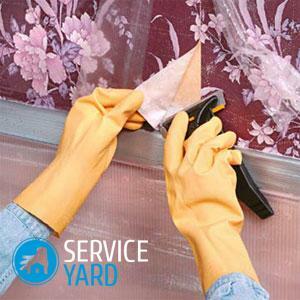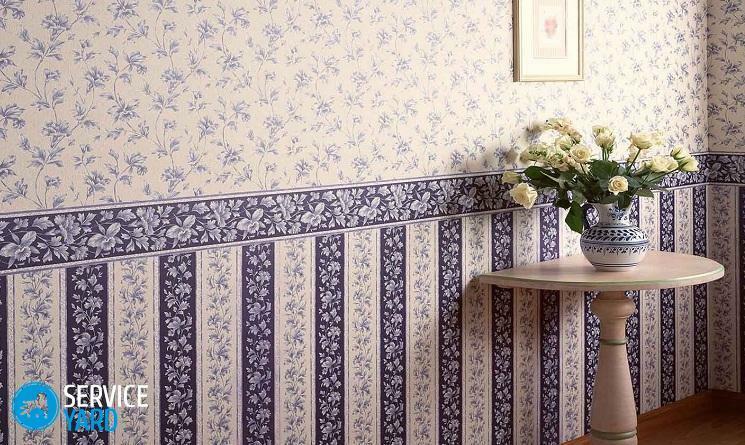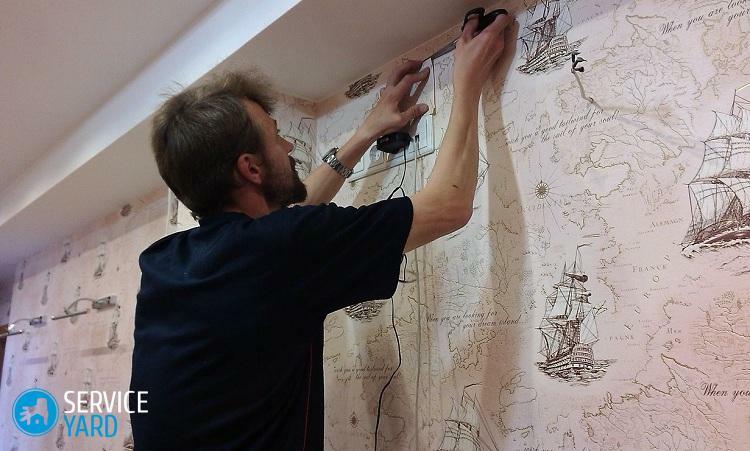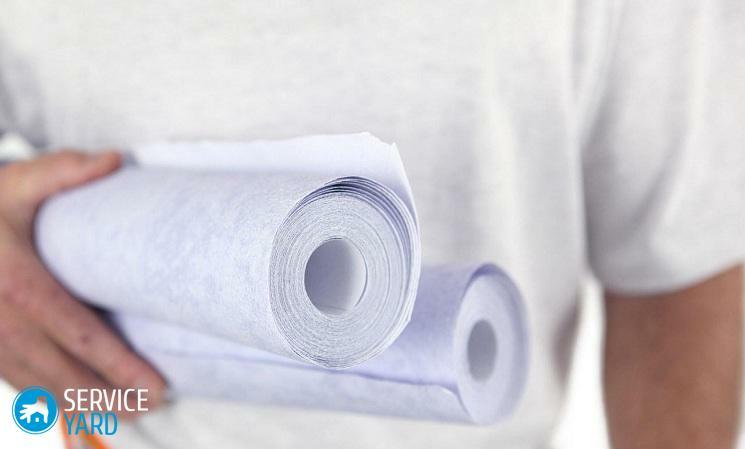
- Which wallpapers are right for you?
- What is plywood?
- Difficulty with plywood
- To avoid moisture
- What are the impregnations?
- We prepare the wall
- Putty
- Let's talk about the errors
- Kleim wallpaper correctly
Wallpaper - perhaps the most popular finishing material, and plywood can serve as a good basis for them. The problem of how to glue wallpaper on plywood is regularly encountered by owners of private wooden houses, as well as the inhabitants of old urban high-rise buildings. The peculiarities of this type of finishing work will be discussed in our article.
to the contents ↑Which wallpapers are suitable?
Can I glue the wallpaper on plywood? You can, but you need to choose the right materials. On the plywood base will hold almost all kinds of wallpaper that are on sale:
- paper;
- vinyl;
- non-woven;
- textile;
- bamboo;
- silk plaster;
- fiberglass wallpaper.
Paper
The easiest way is to glue a plywood partition with paper wallpaper. They are cheap, diverse in texture and color, do not damage health and let in air, allowing the walls to "breathe".
But they have one serious flaw that severely limits their use in this case. They have a fairly thin base, which does not allow you to adjust the unevenness of the wall and joints, and they inevitably form at the junction of the sheets. However, if you properly handle the wall - the problem will disappear by itself.
Vinyl and Nonwoven
These materials are great for gluing wallpapers on plywood. They differ simply in priceless qualities:
- strength;
- longevity;
- perfectly hide small irregularities;
- well hold on plywood walls.

Textiles
Wallpaper fabric will cost more than vinyl and non-woven, and even more so - paper. But they are dense, the base does not shine through them, and in addition, they hide even large cracks and chips.
Bamboo
Another suitable, though rather expensive option - wallpaper from bamboo. Wood with wood glued together easily, these wallpapers are strong, practical and give the interior a special charm.
Important! It is a natural material, that is does not cause allergies, does not accumulate dust, is resistant to moisture. He can serve several decades until he gets bored. But even then, bamboo can be repainted.
Silk plaster and glass
Both options are suitable for the design of any wooden surfaces, including plywood:
- Liquid wallpaper is cheaper, and in addition, with the help of various additives you can make your composition. You can also give the surface any texture, which will make it possible not only to hide the flaws of the wall, but even to turn them into dignities.
- Steklooboi perfectly fit the plywood base. They are durable, in the store you can always choose a more or less budget option. They can be applied even by a beginner finisher, and they adhere to the wall with such wallpaper very well and keep firmly.
What is plywood?
This material has seen everything, but in order to make a beautiful and high-quality finish, you need to know the features of the future basis:
- plywood absorbs moisture;
- absorbing water, significantly increases in size;
- is stratified by water;
- has a dense structure, which sometimes shines through the finish;
- is fastened with metal fittings, which can rust and cause stains on the wallpaper;
- sheets do not fit well.
In this case, the plywood has a lot of positive properties. This is a natural material that is relatively inexpensive. In addition, the panels are good for any materials - if, of course, take into account all the subtleties of working with them, but there are many of them. How to properly glue the wallpaper on plywood to avoid negative consequences?
to the contents ↑Difficulties with plywood
First you need to inspect the surface, which you will be wallpapering. There are two options:
- you are going to put new panels;
- you are going to glue the wallpaper on an old, already fixed partition.
In the first case it is important to choose the right sheets. It is better to give preference to waterproof varieties of plywood. They will cost a little more expensive, but do not have to think, the wall is deformed from frequent water ingress or not.
Important! Do not forget to inspect the surface itself - there should be no visible chips and cracks on it.
The old partition
In this case, you may encounter a number of problems:
- surface crumbles;
- cracks appeared;
- is a blister caused by dampness,
- has resin pockets;
- crumbling joints.
Important! With all this, it's better to finish it in advance. To do this, you will need a grinder or sandpaper with a coarse fraction. Joints are aligned with the help of a masking tape with a retina, the so-called serpentines, and putty.
to the contents ↑To avoid moisture
If you just bought plywood sheets, you will inevitably come across a question: when is it better to process them - before mounting on a wall or after? The first option is more convenient. For starters it is very useful to cover the surfaces with a water repellent compound. If the sheet is not attached to a wall, both sides can be processed. Particular attention should be paid to the edges - they are most susceptible to moisture.
Important! Processing with such a composition is a rather long process. On each side, several layers are applied, and after each surface must completely dry. Of course, when the panel, whether plywood, chipboard or MDF, is already attached to the wall, it is possible to apply impregnation only on one side. Accordingly - the result will be worse.
to the contents ↑What are the impregnations?
Substances that can be impregnated with plywood, so that it does not absorb moisture, is quite a lot. Most commonly used:
- waterproof film;
- drying oil;
- aqueous emulsion of PVA glue;
- is nitro-enamel.
Important! The action of all these substances is based on the fact that they are either absorbed into the tree, filling lacunae that are always there, or else form a layer on the surface that is impermeable to water.
Special impregnation
The most effective option is the use of special impregnations. Time it takes a lot, but the result is worth it. The assortment of such impregnations in building shops is great enough. You must choose those that are designed for interior decoration. Most often used such compounds as:
- "Belinka";
- "Aqualazul".

Olif
There are several types of varnish in building shops:
- natural;
- synthetic;
- is semisynthetic.
Important! The best option is semi-synthetic, it dries much faster than natural. This substance is called "Oxol".Before applying on wooden panels, it is heated to a temperature of 60-70 ° C.
Adhesive PVA and nitro-enamel
Water emulsion of PVA glue gives less qualitative treatment, since the waterproof layer is formed only on the surface. But after applying such a coating, you can do without a primer, putty and without it will hold well.
Nitroemal also gives a surface film. At the same time, this composition protects well from the effect of water.
to the contents ↑We prepare the wall
So, the wallpaper is selected, the panel is impregnated with a water repellent composition - it's time to proceed to further actions. Before you glue the wallpaper on the plywood, the recommendation is to carefully prepare the wall:
- Fasten the fastening elements well - tighten them up to the stop or hammer, depending on what you fastened the panel to.
- If there are protruding nails or nails with a torn cap, pull them out.
- If you have treated the surface with linseed oil or impregnation, apply a layer of soil to the wood.
- Seal the joints so that they do not shine through the wallpaper - this is especially necessary if you are going to glue the paper.
- Scratch all defects.
- Sand the surface with a fine sandpaper.
- Apply one more layer of primer.
- Wait until it is completely dry.
Important! If you have chosen a vinyl wallpaper, the primer should be with antifungal additives.
Why do I need a primer?
Plywood is recommended to be primed almost always before gluing. The primer layer allows the materials to be better bonded. It is best to choose ready-mixed soils. Please note that there is no acetone in the formulation.
to the contents ↑Putty
The plywood panels must be staggered so that there are not too large gaps between the sheets when they are strictly placed one above the other:
- Paint the joints with a mesh band.
- It is possible to glue a reinforcing mesh made of fiberglass on the whole surface.
- It can be with or without adhesive layer - in the second case PVA glue is used.
Important! As for the putty itself, it is possible to use both gypsum and latex. Gypsum is prepared before work from a dry mix, latex - it is sold ready-made, that is, it is a fairly thick paste.
Operation procedure:
- Scratch the joints between the sheets, filling all the slots as much as possible.
- Apply the filler to the entire surface, the layer should be 1-2 mm.
- Grind the surface - you can use grinding mesh with a bar.
Important! During grinding, the sheet can not be held in hands - it must already be fastened to the wall.
to the contents ↑Let's talk about the errors
It's always better to learn from other people's mistakes, not on your own. So let's talk about what happens if the beginner finisher does not follow the rules regarding how to glue the wallpaper on the plywood:
- wallpaper fall down at random;
- wallpaper bloated;
- wallpaper peel off;
- the wall is wet;
- , wrinkles appear on the surface.
Curvature and blistering
If the cloths lie crooked, then the wall has not been properly marked. Alas, it is impossible to fix this, everything will have to be done anew.
Air bubbles indicate that the adhesive was not applied properly. Accordingly - the wallpaper did not fit properly on the wall. In principle, you can cope with this problem. While the glue is not dry, you need to pierce the bubbles and release the air, and then tightly press the damaged piece.

Bleeding
It happens that the wallpaper starts to come unstuck almost immediately. This can mean two things:
- the glue is selected incorrectly;
- the technology of pasting is broken.
When there are not many such places, you can simply glue the fragments off. But if large areas fell off - well, you have to redo the work, but with all the subtleties.
The wall of
becomes wet. The wallpaper will not stick to the too wet wall. This very phenomenon means a very simple thing - before work the surface was not thoroughly dried. What to do? If you did not get to work, just wait.
Wrinkles
If the wallpaper wrinkled - it means that they were badly smoothed when glued. The only way out is to remove the panel, apply glue again, squeeze it against the wall and carefully smooth it.
to the contents ↑Kleim wallpaper correctly
Knowing about possible errors, you can try to avoid them. For pasting walls you will need the following materials and tools:
- actually wallpaper;
- correctly selected glue;
- tableware to dissolve glue%
- construction mixer;
- glue bead;
- knife;
- building level;
- ruler;
- simple pencil;
- rags.
The process itself is not much different from pasting any other surfaces:
- Unpack the wallpaper.
- Place the rolls on the floor.
- Roll rolls, but do not cut anything yet - it's very useful to give the material "get used" to the conditions of a particular room, so it's better if they lie down for a few hours.
- Spread the glue - do not stir it all, better do a little, and then add as needed.
- Mark the walls strictly according to the level.
- Open the wallpaper with a sharp knife.
- Apply glue to the wall or to the canvas.
- Stick the canvas and press it tightly.
- Smooth the wallpaper with a soft rag.
- Remove excess.
In what order to glue canvases - depends on the specific conditions. Many prefer to first glue the corners, and then all the other parts of the wall. If there is a ledge on the wall, it will be more convenient first to trim it, hiding the sections under other panels or pasting the pieces together.
Important! If the wallpaper is glued lapped - the slices should be directed to the direction of the light source, there they will be less noticeable.
In this article we have told you all about how to glue wallpapers on plywood, what mistakes can be made in this work and how to avoid them. We hope, now you understand more all the features of the process and are ready to start repair.



